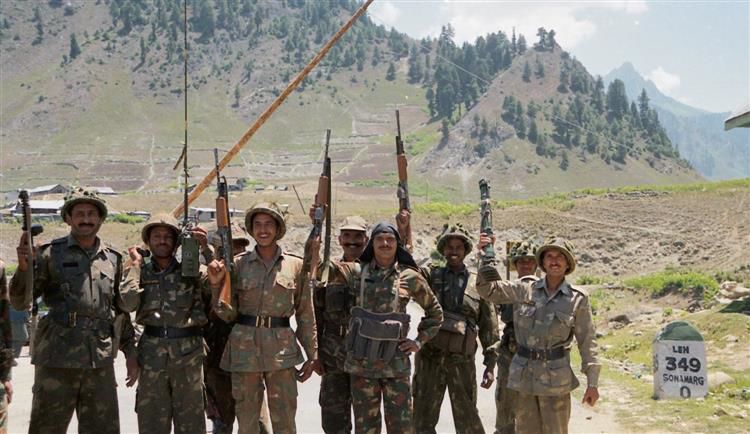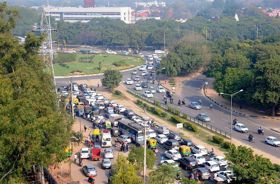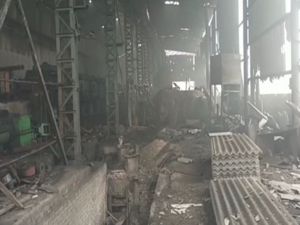
Triumph: Indian officers and soldiers displayed superhuman tenacity in the 1999 war. Tribune file photo
Lt Gen DS Hooda (retd)
Former Northern Army Commander
ON February 20, 1999, then Prime Minister Atal Bihari Vajpayee embarked on a landmark diplomatic visit to Pakistan at the invitation of his Pakistani counterpart, Nawaz Sharif. The next day, the two PMs signed the Lahore Declaration, embodying their shared vision of peace and stability between their countries and of progress and prosperity for their peoples.
The declaration was enthusiastically hailed on both sides of the border, emerging from the shadows of the 1998 nuclear tests that had heightened tensions. Regrettably, the optimism turned out to be illusory. Even as Sharif was greeting Vajpayee at the Wagah border, Pakistani soldiers were crossing the Line of Control (LoC) in the Kargil sector and entrenching themselves on heights like Tololing and Tiger Hill, names that would become ingrained in public memory.
The geography of Kargil, with heights reaching 18,000 ft, posed extraordinary challenges. The war in such extreme conditions was a true test of resilience, and success was achieved because officers and soldiers displayed superhuman tenacity and a willingness to die for the country.
After the initial discovery of intrusions on May 3, a bloody battle lasted nearly three months before India declared victory on July 26. The Pakistan army denied involvement in the fighting and refused to acknowledge its fallen men, an ultimate dishonour to their sacrifice.
Although limited in scale and geographical spread, the Kargil War prompted a deep strategic analysis in both countries. There was a great deal of debate in Pakistan on the miscalculations that led to the conflict and in India on the national security gaps, including an intelligence failure due to which intrusions went undetected. Looking back, we can now assess how effectively the lessons that were learned have been applied by both countries.
Three days after the war, the Indian government constituted the Kargil Review Committee (KRC) to review the events leading to the Pakistani aggression and recommend measures to safeguard national security against armed intrusions. The committee noted that the political, bureaucratic, military and intelligence establishments had developed a vested interest in the status quo. It emphasised the need for a comprehensive review of the national security system, considering the Kargil experience, the ongoing proxy war and the nuclearised security environment.
The Group of Ministers’ (GoM) report, which followed the KRC, was arguably the most comprehensive examination of national security issues undertaken in independent India. Four task forces were established to evaluate the intelligence apparatus, internal security, border management and defence management, underscoring the seriousness of the post-war assessment.
The two reports led to many changes in the management of national security. The National Technical Research Organisation was formed in 2004 to handle centralised communication and electronic intelligence. The Defence Intelligence Agency was formed to cater to the military’s specific intelligence needs. A multi-agency centre was set up to foster better inter-agency information-sharing and coordination.
The defence establishment underwent some restructuring. This included the creation of an Integrated Defence Staff, the founding of the Strategic Forces and Andaman and Nicobar Commands, and the devolution of financial and administrative powers to the three services. The appointment of the Chief of Defence Staff, as recommended by the GoM, was made in 2020.
Some recommendations remain only partially implemented. The GoM had noted: “Multiplicity of forces on the same border has also led to a lack of accountability on the part of the forces. To enforce accountability, the principle of ‘one border, one force’ may be adopted while considering the deployment of forces at the border.” This principle has yet to be applied to the Line of Actual Control with China, where the Indian Army and the Indo-Tibetan Border Police are deployed under different command arrangements.
The GoM pointed out weaknesses such as the absence of a national security doctrine and the lack of commitment of funds to the military beyond the financial year. Other problems that needed to be addressed were greater integration of the service headquarters into the government and jointness in the armed forces. These shortfalls persist.
On the Pakistani side, there was much public debate on the Kargil debacle. The war exposed the skewed nature of civil-military relations, where military objectives were framed without political and diplomatic considerations. Nasim Zehra, in her book From Kargil to the Coup, writes that the army gave then PM Sharif the first detailed briefing on the operation on May 17. By this time, soldiers had already occupied positions across the LoC.
After the war, the role of the Generals who plotted it should have come under scrutiny. Instead, the Pakistan military sought to shift the blame to the political leadership, and growing distrust finally led to the military coup that ousted Sharif from power in October 1999.
The Kargil fiasco brought out forcefully that Pakistan’s use of the military option against India carried no gains. Not only would India react with superior force, but the international community would isolate Pakistan over such action. Rather than finding ways to reduce tensions with India, the Pakistan army fell back on the use of terrorists, and violence escalated in Jammu and Kashmir after the war.
Many experts opined that Pakistan should refrain from becoming obsessed with Kashmir and focus on building a strong economy. Shahid Amin, a former Pakistani diplomat, wrote that the country should become ruthlessly realistic about its limitations and priorities. Pakistan’s survival must precede everything else.
Nevertheless, the core issues that drove Pakistan into an unwinnable conflict remain largely unaddressed. The military still controls the reins in the country, the rhetoric over Kashmir continues, the economy is in dire straits and state support to terrorist organisations persists.
Today, India is a far stronger nation, and a Kargil-type scenario appears unlikely. However, the 1999 conflict revealed a level of recklessness in the Pakistani establishment, and the current state of affairs in that country does little to dispel that impression.
Join Whatsapp Channel of The Tribune for latest updates.



























